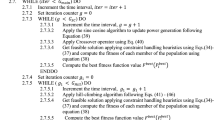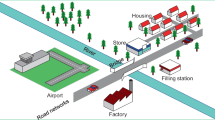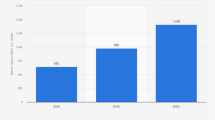Abstract
In this study, an interval fuzzy mixed-integer energy planning model (IFMI-EPM) is developed under considering the carbon tax policy. The developed IFMIEPM incorporates techniques of interval-parameter programming, fuzzy planning and mixed-integer programming within a general energy planning model. The IFMIEPM can not only be used for quantitatively analyzing a variety of policy scenarios that are associated with different levels of carbon tax policy, but also tackle uncertainties expressed as discrete intervals and fuzzy sets in energy and environment systems. Considering low, medium and high carbon tax rates, the model is applied to an ideal energy and environment system. The results indicate that reasonable solutions have been generated. They can be used for generating decision alternatives and thus help decision makers identify desired carbon tax policy.
Similar content being viewed by others
References
Ling B. An interval stochastic two-stage linear programming approach for managing CO2 emission quota in power generation sector. Dissertation for the Doctoral Degree, University of Regina, Regina, 2006
Chen B. Climate change and pesticide loss in watershed systems: a simulation modeling study. Journal of Environmental Informatics, 2007, 10(2): 55–67
Baranzini A, Goldemberg J, Speck S. A future for carbon taxes. Ecological Economics, 2000, 32(3): 395–412
Kambo N S, Handa B R, Bose R K. A linear goal programming model for urban energy-economy-environment interaction. Energy and Building, 1991, 16(1–2): 537–551
Fujii Y, Yamaji K. Assessment of technological options in the global energy system for limiting the atmospheric CO2 concentration. Environmental Economics and Policy Studies, 1998, 1(2): 113–139
Copeland B R, Taylor M S. Free trade and global warming: a trade theory view of the Kyoto protocol. Journal of Environmental Economics and Management, 2005, 49(2): 205–234
Lin Q G, Huang G H, Bass B, Chen B, Zhang B Y. CCEM: a citycluster energy systems planning model. Energy Sources, 2009, 31(4): 273–286
Gnansounou E, Dauriat A, Villegas J, Panichelli L. Life cycle assessment of biofuels: energy and greenhouse gas balances. Bioresource Technology, 2009, 100(21): 4919–4930
Kaygusuz K. Energy and environmental issues relating to greenhouse gas emissions for sustainable development in Turkey. Renewable and Sustainable Energy Reviews, 2009, 13(1): 253–270
Ichinohe M, Endo E. Analysis of the vehicle mix in the passengercar sector in Japan for CO2 emissions reduction by a MARKAL model. Applied Energy, 2006, 83(10): 1047–1061
Cherubini F, Bird N D, Cowie A, Jungmeier G, Schlamadinger B, Woess-Gallasch S. Energy and greenhouse gas-based LCA of biofuel and bioenergy systems: key issues, ranges and recommendations. Resources, Conservation and Recycling, 2009, 53(8), 434–447
Heinrich G, Howells M, Basson L, Petrie J. Electricity supply industry modelling for multiple objectives under demand growth uncertainty. Energy, 2007, 32(11): 2210–2229
Cai Y P, Huang G H, Yang Z F, Lin Q G, Bass B, Tan Q. Development of an optimization model for energy systems planning in the region of Waterloo. International Journal of Energy Research, 2008, 32(11): 988–1005
Nasiri F, Huang G. Integrated capacity planning for electricity generation: a fuzzy environmental policy analysis approach. Energy Sources, 2008, 3(3): 259–279
Rosenthal D H, Edmonds J A, Richards K R, Wise M A. Stabilizing US net carbon emissions by planting trees. Energy Conversion and Management, 1993, 34(9–11): 881–887
Kemfert C, Lise W, Tol R S J. Games of climate change with international trade. Environmental and Resource Economics, 2004, 28(2): 209–232
Lin Q G, Huang G H. Planning of energy system management and GHG-emission control in the Municipality of Beijing-an inexactdynamic stochastic programming model. Energy Policy, 2009, 37(11): 4463–4473
Nahorski Z, Horabik J. Greenhouse gas emission permit trading with different uncertainties in emission sources. Journal of Energy Engineering, 2008, 134(2): 47–52
Mao J, Du Y, Xu L, Zeng Y. Quantification of energy related industrial eco-efficiency of China. Frontiers of Environmental Science & Engineering in China, 2011, 5(4): 1–12
Wang W, Luo Y, Deng Z. Bioenergy recovery from landfill gas: a case study in China. Frontiers of Environmental Science & Engineering in China, 2009, 3(1): 20–31
Manne A S, Richels R G. The EC proposal for combining carbon and energy taxes: the implications for future CO2 emissions. Energy Policy, 1993, 21(1): 5–12
Roughgarden T, Schneider S H. Climate change policy: quantifying uncertainties for damages and optimal carbon taxes. Energy Policy, 1999, 27(7): 415–429
Callan T, Lyons S, Scott S, Tol R S J, Verde S. The distributional implications of a carbon tax in Ireland. Energy Policy, 2009, 37(2): 407–412
Popp M, Nalley L. Funding agricultural carbon offset abatements with carbon tax revenue to reduce net greenhouse gas emissions. In: AAEA & NAREA Joint Annual Meeting 2011. Agricultural and Applied Economics Association, Pittsburgh, 2011, 1–2
Shrestha R M, Pradhan S, Migara H L. Effects of carbon tax on greenhouse gas mitigation in Thailand. Climate Policy, 2008, 8(S1): 140–155
Mongelli I, Tassielli G, Notarnicola B. Carbon tax and its short-term effects in Italy: an evaluation through the input-output model. Handbook of Input-Output Economics in Industrial Ecology, 2009, 23(V): 357–377
Metcalf G E. Designing a carbon tax to reduce US greenhouse gas emissions. Review of Environmental Economics and Policy, 2009, 3(1): 63–83
Amano Y, Ito K, Yoshida S, Matsuoa K, Hashizumea T, Favratc D, Maréchal F. Impact analysis of carbon tax on the renewal planning of energy supply system for an office building. Energy, 2010, 35(2): 1040–1046
Winkler H, Marquard A. Analysis of the Economic Implications of a Carbon Tax. Cape Town: Energy Research Centre, 2009
Xie Y L, Li Y P, Huang G H, Li Y F. An interval fixed-mix stochastic programming method for greenhouse gas mitigation in energy systems under uncertainty. Energy, 2010, 35(12): 4627–4644
Huang G H, Brian W B, Gilles G P. A grey linear programming approach for municipal solid waste management planning under uncertainty. Civil Engineering Systems, 1992, 9(4): 319–335
Lin Q G, Huang G H, Bass B, Qin X S. IFTEM: an interval-fuzzy two-stage stochastic optimization model for regional energy systems planning under uncertainty. Energy Policy, 2009, 37(3): 868–878
Zimmermann H J. Fuzzy programming and linear programming with several objective functions. Fuzzy Sets and systems, 1978, 1(1): 45–55
Xu Y, Huang G H, Qin X S, Huang Y. SRFILP: a stochastic robust fuzzy interval linear programming model for municipal solid waste management under uncertainty. Journal of Environmental Informatics, 2009, 14(2): 72–82
Xu Y, Huang G H, Qin X S. An inexact fuzzy-chance-constrained air quality management model. Journal of the Air & Waste Management Association, 2010, 60(7): 805–819
Huang G H, Baetz B W, Patry G G. A grey fuzzy linear programming approach for municipal solid waste management planning under uncertainty. Civil Engineering Systems, 1993, 10(2): 123–146
Huang G H, Baetz B W, Patry G G. Grey integer programming: an application to waste management planning under uncertainty. European Journal of Operational Research, 1995, 83(3): 594–620
Huang G H, Baetz B W, Patry G G. Grey fuzzy integer programming: an application to regional waste management planning under uncertainty. Socio-Economic Planning Sciences, 1995, 29(1): 17–38
Wang C, Chen J. Parameter uncertainty in CGE modeling of the macroeconomic impact of carbon reduction in China. Tsinghua Science & Technology, 2006, 11(5): 617–624
Author information
Authors and Affiliations
Corresponding author
Rights and permissions
About this article
Cite this article
Zang, H., Xu, Y., Li, W. et al. An uncertain energy planning model under carbon taxes. Front. Environ. Sci. Eng. 6, 549–558 (2012). https://doi.org/10.1007/s11783-012-0414-y
Received:
Accepted:
Published:
Issue Date:
DOI: https://doi.org/10.1007/s11783-012-0414-y




